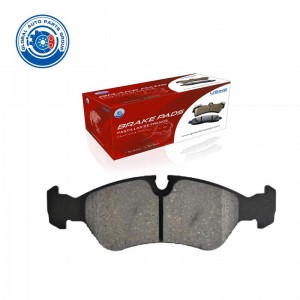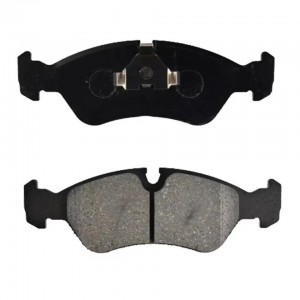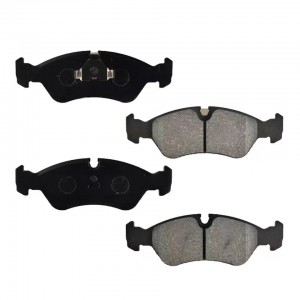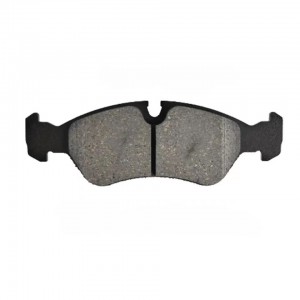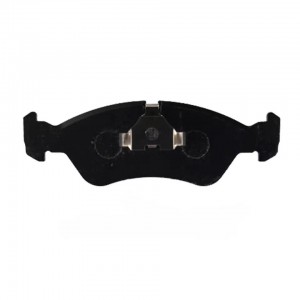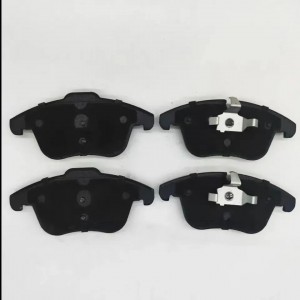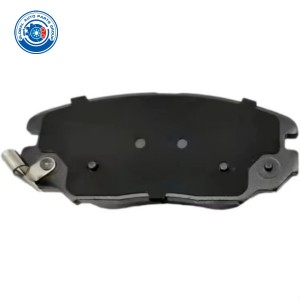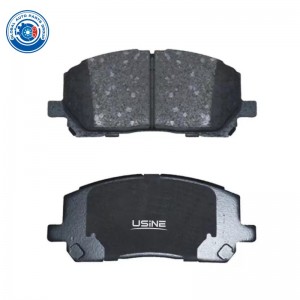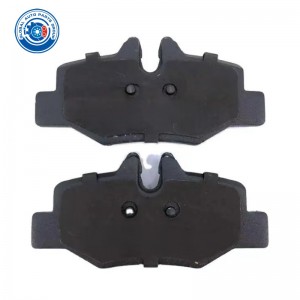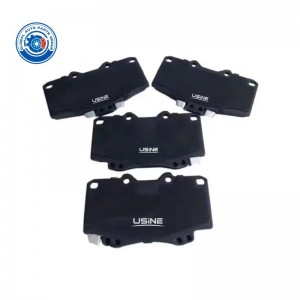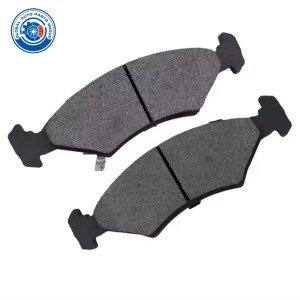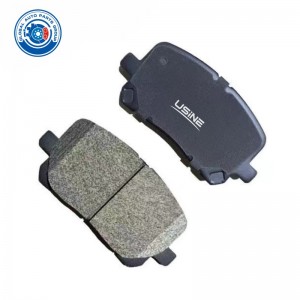High quality brake pads are durable D796
Brake pads are an integral part of the vehicle's braking system and are used to increase friction to achieve the purpose of vehicle braking. Brake pads are usually made of friction materials with wear resistance and high temperature performance. The brake pads are divided into front brake pads and rear brake pads, which are installed on the brake shoe inside the brake caliper.
The main function of the brake pad is to convert the kinetic energy of the vehicle into heat energy and stop the vehicle by contacting the brake disc to generate friction. As brake pads wear out over time, they need to be replaced regularly to maintain good braking performance and safety.
The material and design of the brake pads may vary depending on the vehicle model and usage conditions. In general, hard metal or organic materials are commonly used to make brake pads, and the coefficient of friction of the pad also affects the braking performance.
The selection and replacement of brake pads should follow the vehicle manufacturer's recommendations, and professional technicians should be invited to install and maintain them. Brake pads are an important part of vehicle safety performance, so please always keep them in good condition to ensure safe driving.
Brake pads A-113K is a special type of brake pad. This type of brake pad is commonly used in automobiles. With high wear resistance, high temperature resistance and good braking effect, it can provide stable and reliable braking performance. The specific specifications and applicable models of A-113K brake pads may vary, please choose the right brake pads according to your vehicle type and needs
the specifications of the brake pad model A303K are as follows:
- Width: 119.2 mm
- Height: 68mm
- Height 1: 73.5 mm
- Thickness: 15 mm
These specifications apply to A303K type brake pads. Brake pads are an important part of a vehicle's braking system and are used to provide braking force and friction so that the vehicle can stop safely. Make sure you choose the proper brake pads for your vehicle make and model, and have them installed at a professionally-approved auto repair facility. The selection and installation of brake pads is crucial to the braking performance and safety of your vehicle, so be sure to take appropriate measures to ensure the proper functioning and safety of your braking system.
The specifications of the brake pads are as follows: Width: 132.8mm Height: 52.9mm Thickness: 18.3mm Please note that these specifications apply to the brake pads of the A394K model only. The brake pad is one of the key parts in the vehicle braking system, which is used to provide braking force and friction to ensure the safe parking of the vehicle. So when buying brake pads, make sure you choose the right brake pads for your vehicle make and model, and install them at a car repair shop with professional knowledge. Proper selection and installation of brake pads is critical to the braking performance and safety of your vehicle.
1. Look for warning lights. By replacing the warning light on the dashboard, the vehicle is basically equipped with such a function that when the brake pad has a problem, the brake warning light on the dashboard will light up.
2. Listen to audio prediction. Brake pads are mostly iron, especially after the rain prone to rust phenomenon, at this time stepping on the brakes will hear the hiss of friction, a short time is still a normal phenomenon, accompanied by long-term, the owner will replace it.
3. Check for wear. Check the wear degree of brake pads, the thickness of the new brake pads is generally about 1.5cm, if the wear to only about 0.3cm thickness, it is necessary to replace the brake pads in time.
4. Perceived effect. According to the degree of response to the brake, the thickness and thin of the brake pads will have a significant contrast to the effect of the brake, and you can experience it when braking.
Please owners must pay attention to develop good driving habits at ordinary times, do not often brake sharply, when the red light, you can relax the throttle and slide, reduce the speed by yourself, and gently step on the brake when stopping quickly. This can effectively reduce the wear of the brake pads. In addition, we should also regularly carry out a body check on the car, eliminate the hidden dangers of driving, in order to enjoy the fun of car life
he reasons for the abnormal sound of brake pads: 1, the new brake pads usually the new brake pads need to run in with the brake disc for a period of time, and then the abnormal sound will naturally disappear; 2, the brake pad material is too hard, it is recommended to replace the brake pad brand, the hard brake pad is easy to damage the brake disc; 3, there is a foreign body between the brake pad and the brake disc, which usually does not need maintenance, and the foreign body can fall out after running for a period of time; 4. The fixing screw of the brake disc is lost or damaged, which needs to be repaired as soon as possible; 5, the brake disc surface is not smooth if the brake disc has a shallow groove, it can be polished and smooth, and the deeper it needs to be replaced; 6, the brake pads are too thin brake pads thinner backplane grinding brake disc, this situation to immediately replace the brake pads above will lead to the brake pad abnormal sound, so when the brake abnormal sound, need to first identify the cause, take the appropriate measures
The following situations are compared with brake pads, and the replacement time is usually shorter. 1, the new driver's brake pad consumption is large, the brake is stepped on more, and the consumption will naturally be larger. 2, automatic car automatic brake pad consumption is large, because the manual shift can be buffered by clutch, and the automatic shift depends solely on the accelerator and brake. 3, often drive in the urban streets in the urban streets of the brake pad consumption is large. Because often get on the street in the urban area, there are more traffic lights, stop-and-go, and more brakes. The highway is relatively smooth, and there are relatively few opportunities to brake. 4, often heavy load load car brake pad loss. In the case of deceleration braking at the same speed, the inertia of the car with a large weight is large, so the greater the brake pad friction is required. In addition, we can also check the thickness of the brake pads to determine whether they need to be replaced
The brake form of the vehicle can be divided into disc brakes and drum brakes, brake pads are also divided into two categories: disc and drum. Among them, drum brake pads are widely used in the brake drum of A0 class models, which is characterized by cheap price and strong single braking force, but it is easy to produce thermal decay when continuous braking, and its closed structure is not conducive to the owner's self-test. Disc brakes rely on its high braking efficiency is widely used in modern brake systems, just talk about disc brake pads. Disc brakes are composed of a brake disc connected to the wheel and brake clamps on its edge. When the brake pedal is pressed, the piston in the brake master pump is pushed, building pressure in the brake oil circuit. The pressure is transmitted to the brake pump piston on the brake caliper through the brake oil, and the piston of the brake pump will move outward and push the brake pad to clamp the brake disc after the pressure, so that the brake pad and the brake disc friction to reduce the wheel speed, so as to achieve the purpose of braking.
(a) replacement of the original car brake pads, caused by human factors
1, it may be that the repairman installed the brake pad, and when it is removed, you can see that the surface of the brake pad is only local friction traces. At this point you get the 4S shop to remove and reinstall.
2,After driving for a period of time, it suddenly sounded, mostly because of the hard things on the road such as sand, iron scraps, etc. when stepping on the brake, in which case you can go to the 4S shop for cleaning
3, due to the manufacturer's problem, as a type of brake pad friction block size is inconsistent, especially the width of the friction block, some manufacturers between the size deviation can reach three millimeters. This causes the surface of the brake disc to look smooth, but the large brake pad will also ring if it is mounted on the brake disc that the small brake pad has rubbed against. In such a case, you need to first CD, if not CD can travel for a period of time, and so the trace will not ring after the match.
(2) brake pad material and other product factors caused by noise
If the brake pad material is harder and worse, such as the prohibition of the use of asbestos containing brake pads, but some small manufacturers are still producing and selling asbestos containing brake pads. Semi-metal asbestos-free brake pads although the mileage is long, conducive to environmental protection and human health, but the material is hard and asbestos brake pads due to soft material, often even if there are scratches on the brake disc will not ring, and the brake feels soft, if this is the case of the sound you can only replace the new film.
(3) Abnormal sound of brake pads caused by injury discs
The injury disc referred to here refers to the injury disc in the case of smooth and flat brake disc surface, in addition to the brake pad clamping foreign bodies in the driving process, and is caused by uneven mixing in the production process of the manufacturer. Now the brake disc due to cost reasons, the hardness is much less than before, which leads to semi-metal brake pads are particularly easy to hurt the disc and produce abnormal sound.
(4) Brake pad abnormal sound caused by friction block falling slag or falling off
1, A long time of braking is easy to lead to slag or fall off. This situation is mainly in mountainous areas and highways appear more. In the mountains the slopes are steep and long. Experienced drivers will use the spot brake downhill, but novices often continuous braking for a long time, so it is easy to cause the chip ablation slag off, or the driver often travels faster than the safe speed when driving on the highway. In the event of an emergency, the point brake often loses its function and must be continuously braking. This kind of long braking often causes the chip to ablate the slag and remove the block, resulting in abnormal brake pad noise.
2.If the brake caliper does not return for a long time, it will cause the temperature of the brake pad to be too high, resulting in the ablative deterioration of the friction material, or the failure of the adhesive resulting in abnormal sound.
The brake pump is rusty
If the brake oil is not replaced for a long time, the oil will deteriorate, and the moisture in the oil will react with the pump (cast iron) to rust. Resulting in friction abnormal sound
(6) The thread is not alive
If one of the two hand pull wires is not alive, it will cause the brake pad to be different, then you can adjust or replace the hand pull wire.
(7) Slow return of the brake master pump
Slow return of the brake master pump and abnormal return of the brake sub-pump will also lead to abnormal brake pad sound.
There are so many reasons for the abnormal ring of brake pads, so how to deal with the abnormal ring of brake pads, first of all, we have to analyze what kind of abnormal ring of the situation and then targeted processing.
| 36667 | BL1260A2 | FD6277A | 90 398 760 | 31706 | 93213479 |
| AC443381D | 6109512 | FD6277N | 90 399 495 | 2119003 | 11046952012 |
| PAD892 | 13600903 | 5003376 | 90 496 733 | 21190 175 0 5 T490 | T1082ECO |
| 50-03-376 | 2645 | 13046059252 | 90 496 734 | 8110 10550 | 7089 |
| 600039 | 180758 | 13046070522 | 93192637 | 8110 24891 | 7452 |
| 605925 | 181366 | 13046370522 | 93 213 479 | 119 | 28610 |
| 607052 | PA-376AF | 986491900 | 1104 6952 012 | GDB3116 | 28620 |
| 13.0460-5925.2 | 881605911 | 120417 | 9588 | GDB951 | 28630 |
| 13.0460-7052.2 | 571391D | 7666D796 | 9650 | 598184 | 228610 |
| 13.0463-7052.2 | 5713911 | D7967666 | T1021 | P3863.10 | 228620 |
| 571391B | 5713911-AS | PA376AF | T1082-ECO | P3863.30 | 228630 |
| 571391X | 90 297 770 | 571391JAS | 7.089 | 21190 | SP122 |
| DB1228 | 05P304 | 5713911AS | 7.452 | 21201 | 2119017505T490 |
| 0 986 491 900 | 363702160258 | 2201170 | BLF450 | 21190.180.1 | 811010550 |
| PA511 | 363702161031 | 28650 | BP450 | 1605696 | 811024891 |
| LP585 | 3.63702E+11 | 252119017 | T0610485 | 1605746 | 1190 |
| 12-0417 | 6318 | 13600900 | 286.1 | 1605789 | P386310 |
| AF11170 | 22-0117-0 | 223607 | 286.3 | 1605808 | P386330 |
| FDB584 | 286.2 | 21862 | 2286.1 | 11046152 | 211901801 |
| FDS584 | 286.5 | 1605454 | 2286.2 | 90297770 | SP1078 |
| FSL584 | 025 211 9017 | 1605 696 | 2286.3 | 90398760 | SP 122 |
| TAR584 | 248 | 1605 746 | 443381 | 90399495 | CD8173 |
| 7666-D796 | MDB1386 | 1605 789 | D999 | 90496733 | D796-7666 |
| D796 | D11170 | 1605 808 | 1104 6152 | 90496734 |
| DAEWOO Noble Saloon (KLEJ) 1991/10-1999/09 | Astra F Convertible 2.0 i | Astra F Hatchback 2.0 GSI 16V | Omega A four-door sedan (16_, 17_, 19_) 2.0 i | VITA B 1.6 i 16V | Vauxhall Calton Mk III Saloon 1986/09-1994/03 |
| Noble Saloon (KLEJ) 1.5 | Opel Astra F Touring 1991/09-1998/01 | Astra F hatchback 2.0 i | Omega A four-door sedan (16_, 17_, 19_) 2.3 D | Opel Vectra B Touring 1996/11-2003/07 | Calton Mk III four-door sedan 1.8 |
| Noble sedan (KLEJ) 1.5 16V | Astra F Touring Edition 1.4 | Astra F hatchback 2.0 i 16V | Omega A Sedan (16_, 17_, 19_) 2.3 TD Interc. | VITA B Travel Edition 1.6 i 16V | Calton Mk III four-door sedan 1.8 i |
| Noble Saloon (KLEJ) 1.8 | Astra F Touring Edition 1.4 i | Opel Astra F Box 1991/10-1999/01 | Omega A four-door sedan (16_, 17_, 19_) 2.4 i | Opel Vectra B Hatchback 1995/10-2003/07 | Calton Mk III Saloon 1.8 N |
| Noble Saloon (KLEJ) 1.8 | Astra F Touring Edition 1.4 i 16V | Astra F Box 1.7 D | Opel Omega A station wagon (66_, 67_) 1986/09-1994/05 | Vectra B hatchback 1.6 i 16V | Calton Mk III four-door sedan 1.8 S |
| Noble Saloon (KLEJ) 2.0 | Astra F Touring Edition 1.6 | Astra F Box 1.7 D | Omega A station wagon (66_, 67_) 2.0 | Vauxhall Astra Mk II Saloon 1985/09-1991/12 | Calton Mk III four-door sedan 2.0 |
| Noble Saloon (KLEJ) 2.0 | Astra F Touring Edition 1.6 i | Astra F Box 1.7 TD | Omega A station wagon (66_, 67_) 2.0 i | Astra Mk second-generation four-door sedan 1.8 | Calton Mk III four-door sedan 2.0 |
| DAEWOO NEXIA Hatchback/Hatchback (KLETN) 1995/02-1997/08 | Astra F Touring Edition 1.6 i 16V | OPEL Cadet E Saloon (39_, 49_) 1984/09-1993/12 | Omega A station wagon (66_, 67_) 2.0 i | Astra Mk II four-door sedan 1.8 i | Calton Mk III four-door sedan 2.0 |
| NEXIA Hatchback/Hatchback (KLETN) 1.5 16V | Astra F Touring 1.6 Si | Cadet E Saloon (39_, 49_) 1.8 | Omega A station wagon (66_, 67_) 2.3 D | Vauxhall Astra Mk II Convertible 1987/01-1993/08 | Calton Mk III four-door sedan 2.3 D |
| DAEWOO NEXIA Saloon (KLETN) 1995/02-2008/06 | Astra F Touring Edition 1.7 D | Cadet E Saloon (39_, 49_) 1.8 i | Omega A station wagon (66_, 67_) 2.3 TD Interc. | Astra Mk II convertible 2.0 i | Calton Mk III Saloon 2.3 TD Interc. |
| NEXIA Sedan (KLETN) 1.5 16V | Astra F Touring Edition 1.7 D | Cadet E Saloon (39_, 49_) 1.8 i | Omega A station wagon (66_, 67_) 2.4 i | Astra Mk II Convertible 2.0 i CAT | Vauxhall Cavalier Mk II Hatchback/Hatchback 1981/09-1988/08 |
| Opel Astra F 1991/09-1998/09 | Astra F Touring 1.7 TD | Cadet E Saloon (39_, 49_) 2.0 i | Opel Vectra A 1988/08-1995/12 | Vauxhall Astra Mk III Convertible 1991/09-2001/03 | Cavalier Mk II hatchback/hatchback 2.0 SRi 130 |
| Astra F 1.4 | Astra F Touring Edition 1.7 TDS | Cadet E Saloon (39_, 49_) 2.0 i CAT | VITA A 1.8 S 4×4 | Astra Mk III Convertible 2.0 i | Cavalier Mk 2nd Generation Hatchback/Hatchback 2000i |
| Astra F 1.4 | Astra F Touring Edition 1.8 i 16V | OPEL Cadet E Convertible (43B_) 1986/10-1993/02 | Vectra A 2.0 | Vauxhall Cavalier Mk II Saloon 1981/09-1988/08 | |
| Astra F 1.4 i | Astra F Touring Edition 1.8 i 16V | Cadet E Convertible (43B_) 2.0 i | Vectra A 2.0 i | Vauxhall Astra Mk III station wagon 1991/03-1998/02 | Cavalier Mk II Saloon 2.0 SRi 130 |
| Astra F 1.4 i 16V | Astra F Touring Edition 2.0 i | Cadet E Convertible (43B_) 2.0 i CAT | Vectra A 2.0 i | Astra Mk 3rd generation station wagon 2.0 i | Vauxhall Cavalier Mk III Hatchback/Hatchback 1988/09-1995/11 |
| Astra F 1.4 Si | Astra F Touring Edition 2.0 i 16V | OPEL Cadet E station wagon (35_, 36_, 45_, 46_) 1984/09-1991/08 | VITA A 2.0 i 16V | Vauxhall Astra Mk III Hatchback/Hatchback 1991/09-1998/02 | Knight Mk III Hatchback/Hatchback 1.8 |
| Astra F 1.6 | Astra F Touring Edition 2.0 i 16V | Cadet E Wagon (35_, 36_, 45_, 46_) 1.8 E | VITA A 2.0 i 16V 4×4 | Astra Mk third generation hatchback/hatchback 1.6 i | Knight Mk III Hatchback/Hatchback 1.8 i CAT |
| Astra F 1.6 i | Opel Astra F Hatchback 1991/09-1998/01 | Cadet E station wagon (35_, 36_, 45_, 46_) 1.8 i | VITA A 2.0 i 4×4 | Astra Mk third generation hatchback/hatchback 2.0 i | Cavalier Mk III Hatchback/Hatchback 2.0 i |
| Astra F 1.6 i | Astra F hatchback 1.4 | Cadet E station wagon (35_, 36_, 45_, 46_) 1.8 i | VITA A 2.0 i 4×4 | Astra Mk third generation hatchback/hatchback 2.0 i 16V | Knight Mk third generation hatchback/hatchback 2.0 i 16V |
| Astra F 1.6 i | Astra F hatchback 1.4 | Cadet E Wagon (35_, 36_, 45_, 46_) 1.8 S | VITA A 2.0 i CAT | Vauxhall Astra Mk III Saloon 1991/09-1998/09 | Knight Mk third generation hatchback/hatchback 2.0 i 16V |
| Astra F 1.6 i 16V | Astra F hatchback 1.4 i | Cadet E station wagon (35_, 36_, 45_, 46_) 2.0 i | Vectra A 2.0 i Cat 4×4 | Astra Mk III four-door sedan 2.0 i | Knight Mk III hatchback/hatchback 2.0 i 4×4 |
| Astra F 1.6 Si | Astra F hatchback 1.4 i 16V | Cadet E station wagon (35_, 36_, 45_, 46_) 2.0 i CAT | Vectra A 2000 16V 4×4 | VAUXHALL CALLE (CALIBRA) COUPE 1990/06-1997/07 | Knight Mk III hatchback/hatchback 2.0 i 4×4 |
| Astra F 1.7 D | Astra F Hatchback 1.4 Si | Opel Cadet E Hatchback/Hatchback (33_, 34_, 43_, 44_) 1984/09-1991/08 | Vectra A 2000/GT 16V | Jiali (Calibra) coupe 2.0 i | Knight Mk III Hatchback/Hatchback 2.0 i CAT |
| Astra F 1.7 D | Astra F hatchback 1.6 | Non-commissioned officer E Xinbei/Hatchback (33_, 34_, 43_, 44_) 1.8 E | VITA A 2000/GT 16V CAT | Jiali (Calibra) coupe 2.0 i 16V | Knight Mk III Hatchback/Hatchback 2.0 SRi |
| Astra F 1.7 TD | Astra F hatchback 1.6 i | Soldier E Xinback/Hatchback (33_, 34_, 43_, 44_) 1.8 i | Vectra A 2000/GT 16V Cat 4×4 | Jiali (Calibra) coupe 2.0 i 16V | Vauxhall Cavalier Mk III Saloon 1988/08-1995/11 |
| Astra F 1.7 TDS | Astra F hatchback 1.6 i | Cadet E Hatchback/Hatchback (33_, 34_, 43_, 44_) 2.0 GSI | Opel Vectra A Hatchback 1988/04-1995/12 | Jiali (Calibra) coupe 2.0 i 16V 4×4 | Knight Mk III four-door sedan 1.8 |
| Astra F 1.8 i 16V | Astra F hatchback 1.6 i 16V | Cadet E Hatchback/Hatchback (33_, 34_, 43_, 44_) 2.0 GSI | VITA A Hatchback 2.0 | Jiali (Calibra) coupe 2.0 i 16V 4×4 | Knight Mk III four-door sedan 1.8 i CAT |
| Astra F 1.8 i 16V | Astra F Hatchback 1.6 Si | Cadet E Hatchback/Hatchback (33_, 34_, 43_, 44_) 2.0 GSI 16V | Vectra A hatchback 2.0 i | Jiali (Calibra) coupe 2.0 i 4×4 | Cavalier Mk III Saloon 2.0 i |
| Astra F 2.0 i | Astra F Hatchback 1.7 D | Cadet E Hatchback/Hatchback (33_, 34_, 43_, 44_) 2.0 GSI 16V CAT | Vectra A hatchback 2.0 i 16V | Vauxhall Carlton Mk III station wagon 1986/09-1994/03 | Cavalier Mk III Saloon 2.0 i 16V |
| Astra F 2.0 i 16V | Astra F Hatchback 1.7 D | Cadet E Hatchback/Hatchback (33_, 34_, 43_, 44_) 2.0 GSI CAT | Vectra A hatchback 2.0 i 16V | Karlton Mk 3rd generation station wagon 2.0 | Cavalier Mk III Saloon 2.0 i 4×4 |
| Opel Astra F Convertible 1993/03-2001/03 | Astra F Hatchback 1.7 TD | Opel Omega A Sedan (16_, 17_, 19_) 1986/09-1994/05 | VITA A Hatchback 2.0 i 16V CAT | Karlton Mk 3rd generation station wagon 2.0 | Cavalier Mk III Saloon 2.0 i 4×4 |
| Astra F Convertible 1.4 i 16V | Astra F Hatchback 1.7 TDS | Omega A Sedan (16_, 17_, 19_) 2.0 | VITA A Hatchback 2.0 i CAT | Calton Mk 3rd generation station wagon 2.0 i | Cavalier Mk III Saloon 2.0 i CAT |
| Astra F Convertible 1.6 i | Astra F hatchback 1.8 i 16V | Omega A Sedan (16_, 17_, 19_) 2.0 | Vectra A hatchback 2.0 i GT | Karlton Mk 3rd generation station wagon 2.3 D | Knight Mk III Saloon 2.0 SRi |
| Astra F Convertible 1.8 i 16V | Astra F hatchback 1.8 i 16V | Omega A Sedan (16_, 17_, 19_) 2.0 | Opel Vectra B 1995/09-2002/07 | Calton Mk 3rd generation station wagon 2.3 TD Interc. | Knight Mk III Saloon 2.0 SRi 16V |





